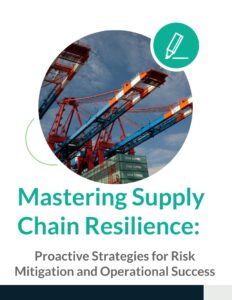We all know that financial stability is paramount. Yet, many companies face the challenge of a bleeding bottom line. What should you do? If this resonates with you, you’re not alone. The good news is that effective financial turnaround strategies can halt financial losses, optimize operations, and safeguard the future of your business. In this discussion, we’ll explore proven strategies we’ve employed with our clients to identify issues, stem the bleeding, and alleviate your concerns.
Struggling with a declining bottom line can be overwhelming and disheartening. However, with the right strategies, you can reverse this trend and set your business on a path to profitability and growth. We’ll go through practical, actionable steps to achieve a financial turnaround. We’ll cover everything from cutting unnecessary costs and optimizing processes to leveraging technology and enhancing decision-making. Whether you’re a business leader or a finance professional, these insights will help you tackle financial challenges head-on.
Understanding the Financial Bleeding
To effectively stop financial losses, it’s essential to not only understand their sources and underlying causes but also to develop a robust strategy for addressing them. This goes beyond merely examining spreadsheets and financial statements; it necessitates a comprehensive analysis of your business’s overall health and operations. Begin by assessing various aspects of your organization, including budgeting processes, financial forecasting, and resource allocation.
Look for common warning signs such as increasing debt levels, reliance on manual workarounds, declining customer satisfaction, and inconsistent revenue streams. These indicators often signal deeper issues that need to be addressed. Early identification of these problems allows you to take proactive measures before they escalate into more significant challenges.
Regular financial audits and performance reviews can reveal the root causes of financial distress, whether they arise from ineffective cash flow management, overspending on unnecessary expenses, or operational inefficiencies that hinder productivity. By scrutinizing these areas, you can implement targeted changes, streamline processes, and improve overall financial health, ultimately leading to sustainable growth and profitability. Additionally, fostering a culture of financial awareness among employees can empower them to contribute to a more financially stable organization.
Conducting a Financial Health Check
A comprehensive financial health check is the crucial first step in any turnaround strategy. This process involves a thorough examination of trends in revenue, expenses, and profitability over time, allowing organizations to gain valuable insights into their financial performance. It’s important to identify any anomalies or red flags that may signal deeper issues within the business. For instance, are there specific inefficiencies within your operations that are contributing to rising costs, elongated production times, or excessive inventory levels? A thorough analysis of these factors can reveal underlying problems that, if left unaddressed, may hinder your business’s performance and profitability. Furthermore, evaluating cash flow patterns is crucial; understanding how money moves in and out of your business can provide insights into your financial health. Additionally, gaining a clear understanding of customer payment behaviors—such as the average time it takes for invoices to be settled—can help identify potential cash flow issues before they escalate. Assessing market conditions, including trends and competitive dynamics, is also essential for making informed decisions. By addressing these critical questions and insights, you can lay a solid foundation for a successful financial turnaround. This groundwork is vital for implementing effective strategies that not only restore financial stability but also promote sustainable growth in the long run, ensuring your business remains resilient in a constantly evolving market landscape.
Cut Unnecessary Costs Without Sacrificing Quality
Reducing costs is a vital part of any financial turnaround strategy, but it’s crucial to do so without compromising the quality of your products or services. A well-implemented cost-reduction strategy can lead to significant improvements in profitability, ultimately ensuring the long-term sustainability of the business. Begin by carefully reviewing your expenses to identify non-essential costs that can be eliminated or reduced. This process may involve scrutinizing each line item in your budget and determining which expenditures truly add value to your operations.
Consider renegotiating supplier contracts to secure better rates or terms, which can lead to substantial savings. Diversifying your supplier base can also create more competitive pricing and reduce dependency on a single vendor. Additionally, cutting back on discretionary spending can free up resources without impacting core business functions. For a more strategic approach, seek out cost-effective alternatives that maintain quality but lower expenses, such as switching to more affordable materials or adopting new technologies that enhance productivity.
Furthermore, explore how technology can streamline information management and provide a clearer overview of business expenses, trends, indirect procurement spending, and energy waste. Implementing financial management software can help track spending in real-time, allowing for quicker adjustments and better decision-making. By leveraging data analytics, you can identify patterns and areas for improvement, ensuring that your cost-reduction efforts are both effective and sustainable in the long run.
Optimize Your Workforce
Often, businesses tackle problems by hiring more staff, assuming that added personnel will alleviate issues. However, this approach can inflate payrolls without addressing the root problems. Instead of simply adding more people, it’s more effective to optimize your existing workforce.
Streamlining roles and responsibilities ensures each team member understands their specific contributions to the organization. Investing in upskilling your current team enhances effectiveness and boosts overall performance. By providing targeted training opportunities, you increase their skills and foster a culture of continuous learning. Start by assessing your staff’s competencies and identifying skill gaps that might hinder productivity.
Implement training programs that align with individual career goals and organizational objectives, like workshops, online courses, or mentorships focused on essential skills such as leadership, project management, digital literacy, and problem-solving. Encourage cross-training to give employees a broader understanding of different functions, leading to greater collaboration and flexibility.
A robust feedback mechanism can evaluate these programs’ effectiveness and give employees actionable insights into their performance. Recognizing and rewarding those who engage in upskilling not only motivates them but also emphasizes the value of professional development. By upskilling your workforce, you cultivate a more competent, adaptable, and committed team ready to navigate challenges and contribute to your business’s long-term success.
Enhancing training and development programs empowers employees with the skills needed to excel in their roles, fostering continuous improvement. Implementing strong performance management systems provides clear success metrics and facilitates constructive feedback. By taking these steps, you ensure every employee contributes effectively to the company’s goals, leading to a more efficient and productive work environment.
Replace Legacy Systems with Modern Solutions
Legacy systems can be a significant drain on resources, both in terms of maintenance costs and inefficiency. These outdated systems often require ongoing support and can hinder an organization’s ability to innovate and respond to market demands. Modernizing your technology stack is essential, as it can lead to substantial savings and improved productivity across various departments.
By evaluating your current systems, you can identify specific areas where newer, more efficient solutions can be implemented. This might include adopting cloud-based software that offers scalability and flexibility, utilizing automation tools to streamline repetitive tasks, or integrating platforms that enhance collaboration and data management among teams. Embracing these modern technologies not only reduces costs but also positions your organization to leverage data-driven insights, improve customer experiences, and stay competitive in a rapidly evolving landscape.
Automate Manual Processes
Manual processes are often prone to errors and inefficiencies, which can lead to wasted time and increased costs for businesses. By automating these processes, organizations can achieve significant savings in both time and money, while also enhancing accuracy and productivity.
To begin, it’s crucial to identify repetitive tasks that can be streamlined through technology. Common areas ripe for automation include accounting functions—such as invoicing and payroll—customer service operations, where chatbots can handle basic inquiries, and inventory management, which can benefit from automated tracking systems.
Investing in automation not only cuts operational costs but also empowers your team by freeing up their time to focus on more strategic activities, such as innovation and customer engagement. This shift allows businesses to operate more efficiently, adapt to changes in the market faster, and ultimately drive growth in a competitive landscape. Embracing automation is not just a trend; it is a vital strategy for long-term success in today’s fast-paced business environment.
Leverage Data for Informed Decision-Making
Data-driven decision-making is vital for achieving a successful financial turnaround. By systematically gathering and analyzing data from diverse sources—such as sales figures, customer feedback, market trends, and operational metrics—business leaders can gain critical insights into their overall performance. This comprehensive understanding allows them to pinpoint specific areas for improvement, allocate resources effectively for maximum impact, and develop the most effective strategies for implementation.
Moreover, integrating business intelligence tools into your operations can significantly enhance this process. These tools not only facilitate the visualization of complex data sets but also allow for real-time tracking of key performance indicators (KPIs). By monitoring KPIs such as revenue growth, profit margins, and customer acquisition costs in real time, organizations can make timely adjustments to their strategies, ensuring they remain agile and responsive to changing market conditions. Ultimately, a robust data-driven approach empowers businesses to make informed decisions that drive sustainable growth and profitability.
Enhance Cash Flow Management
Effective cash flow management is essential for maintaining financial stability. Monitor your cash flow regularly to ensure you have sufficient liquidity to meet your obligations. Implement strategies to accelerate receivables, such as offering discounts for early payments or improving your invoicing process. Additionally, manage your payables strategically to optimize cash flow without straining your relationships with suppliers.
Focus on Core Competencies
Diversifying your business can be beneficial, but it can also spread your resources too thin. During a financial turnaround, it’s crucial to focus on your core competencies. Identify the products or services that drive the most value for your business and concentrate your efforts there. Streamline your operations to align with your core strengths and eliminate activities that do not contribute to your primary objectives.
Improve Customer Retention
Acquiring new customers is significantly more expensive than retaining existing ones, often requiring extensive marketing budgets and resources. Enhancing customer retention can lead to increased revenue, enhanced brand loyalty, and greater profitability in the long run. To achieve this, it is vital to focus on building strong, meaningful relationships with your customers. This can be accomplished by providing exceptional service that goes above and beyond their expectations, actively addressing their needs and concerns, and offering enticing loyalty programs that reward their continued patronage.
Moreover, regularly soliciting feedback through surveys or direct communication can help you understand their pain points and expectations more clearly. This invaluable information can then be leveraged to refine and improve your offerings, ensuring they align closely with what your customers truly want. By fostering a customer-centric approach, businesses can create a loyal customer base that not only returns but also advocates for the brand, driving growth through positive word-of-mouth and referrals.
Negotiate with Creditors and Suppliers
Negotiating with creditors and suppliers can offer essential relief for your financial situation. Begin by engaging in open communication with your creditors to discuss your circumstances and explore the options they may provide. This level of transparency can build trust and potentially result in more favorable terms, such as extended payment periods or reduced interest rates, which can greatly alleviate your cash flow challenges.
Similarly, it’s important to engage with your suppliers; take the time to renegotiate contracts and explore options for discounts or payment flexibility. Building strong relationships with these key stakeholders can lead to mutually beneficial agreements that not only help you manage your current debt but also strengthen your business for the future. By fostering collaboration and understanding, you can create a supportive network that contributes to your long-term success while navigating financial difficulties.
Evaluate and Adjust Your Pricing Strategy
Pricing plays a crucial role in your profitability. Evaluate your current pricing strategy to ensure it aligns with your business goals and market conditions. Consider factors such as production costs, competitor pricing, and customer value perception. Adjust your prices if necessary to reflect the true value of your products or services. Implementing dynamic pricing models can also help you maximize revenue based on demand fluctuations.
Invest in Marketing and Sales
During a financial turnaround, it might be tempting to cut back on marketing and sales efforts. However, investing in these areas can drive growth and profitability. Focus on targeted marketing campaigns that reach your ideal customers. Leverage digital marketing channels, such as social media, content marketing, and email marketing, to increase your brand visibility and attract new customers. Implement sales strategies that emphasize value and address customer pain points.
Monitor Progress and Adapt
Financial turnarounds require ongoing monitoring and adaptation. Regularly review your financial performance and assess the effectiveness of your strategies. Use KPIs to track your progress and identify areas that need further improvement. Be prepared to adapt your approach based on changing market conditions, new opportunities, or emerging challenges. Flexibility and agility are key to sustaining your financial recovery.
Conclusion
Turning around a bleeding bottom line is no small feat, but with the right strategies, it’s entirely achievable. By conducting a thorough financial health check, cutting unnecessary costs, optimizing your workforce, and leveraging technology, you can set your business on a path to financial stability and growth. Remember to focus on data-driven decision-making, enhance cash flow management, and prioritize customer retention. With continuous monitoring and adaptation, you’ll be well-equipped to overcome financial challenges and achieve long-term success. To take the next step in your financial turnaround journey, consider consulting with experts or exploring additional resources tailored to your specific needs.
By implementing these strategies, your business can not only stop the financial bleeding but also build a solid foundation for sustained growth and profitability. Stay committed, stay informed, and stay proactive in your approach to financial management. Your future success depends on the actions you take today.







